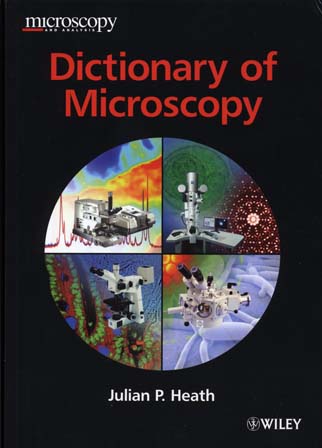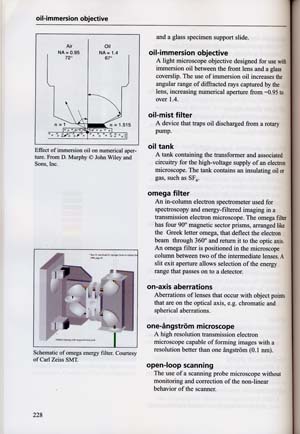Dictionary of Microscopy
Dictionary of Microscopy
By Julian P. Heath
John Wiley & Sons, Ltd
The Atrium, Southern Gate
Chichester, West Sussex PO19 8SQ England
Tel: +44 (0)1234 779777
www.wiley.com
Orders and customer service inquiries, email: cs-books@wiley.co.uk.
ISBN-13: 978-0-470-01199-7 | ISBN-10: 0-470-01199-8
357 pages, illustrated with monochrome and colored drawings and photographs
Softbound – $50.00(US)

The author, Dr. Julian P. Heath, is editor of the journal Microscopy and Analysis. The journal’s name/logo appears on the cover in the upper left corner, across from Wiley’s name and logo in the lower right. I was unable to find a reference defining the relationship between the journal and the publisher. The cover is shown in Figure 1.
This book is a dictionary of microscopy, not an encyclopedia. Thus, its intent is to be the first source for a concise definition of an unfamiliar (or familiar) term, not a thorough (or even brief) discussion of the technology behind the word or concept under investigation. What it lacks in depth, however, it excels in breadth, as it provides the reader with a handle on terminology used throughout the microscopy and microanalytical communities, both biological and materials scientists. Its topics include optics, light microscopy of all kinds, including photon-based spectroscopies, such as infrared and Raman, electron microscopies of all varieties, and scanning probe microscopy. Additionally, both imaging and specimen preparation are well represented.
Organization
This book is a thoroughly modern product of the publishing industry, as exemplified by the book’s organization. The emphasis is on making the information quickly accessible.
It begins with a Preface by the author (one page), followed by a list of Sponsors (one page) and Acknowledgements (one short page).
Next comes a list of acronyms, a seven-page list of terms both familiar and obscure. It is wonderful to have all the many acronyms available in one location, although even an ambitious effort such as this is bound to lack a few. Surveying this list, I immediately noticed that a number of terms in common use were absent. For example, EDX was listed for energy-dispersive x-ray spectroscopy, but EDS, another commonly used term (and the standard acronym used at McCrone and many other facilities) was not present. Also absent is PLM, the acronym for polarized light microscopy, although LM is listed for light microscopy, as well as for low magnification. Infrared spectroscopy also gets short shrift: FT for Fourier transform is present, but FTIR (Fourier transform infrared spectroscopy) is absent, as is any other designation for infrared spectroscopy such as simply IR.
The bulk of the book consists of brief definitions, often accompanied by small but high quality illustrations, in a two-column format (Figure 2). The definitions pare down the information to the bare bone, but I find myself agreeing with the author more often than not–these are, after all, definitions, not essays, and the reader should seek more detailed information elsewhere.

The Bibliography section might be considered rather short at just four pages, but, as the author indicates, it lists only the primary sources used. As it is, it could be considered a good survey of the currently available books, journals and websites (yes, we’ve reached a stage in our intellectual history such that websites have become citable), especially considering the fact that most of the most recently developed microscopical innovations have a rather short history.
The Bibliography section is followed by a list called Sponsor Information (three pages, with twenty sponsors). Each entry consists of a company logo, with the company name to the right, and contact information, including mailing addresses and websites (no phone numbers) on the far right. At first this struck me as a little odd in a scholarly publication, but, on further consideration, it seems both OK and appropriate, as the technologies are driven by the industries. However, the publisher makes it quite clear that it is not associated with any product or vendor mentioned in the book.
As a final thought, the back cover blurb mentions that “The past decade has seen huge advances in the application of microscopy in all areas of science,” and this book was created to directly address the new concepts and terminology of this exploding field—and it does it well.
Comments
add comment